A HUNDRED YEARS OF CAMDEN'S RCA BUILDING 17
Former Employees Pack Centennial Event in Famed "Nipper" Landmark
By Hoag Levins
 | |
 July 17, 2009
July 17, 2009
CAMDEN, N.J. -- Thrust up from the skyline of Camden as distinctly as a lighthouse, the Nipper Tower on RCA's
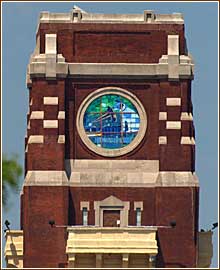
Photo: Hoag Levins
|
| The Nipper Tower is one of Southern New Jersey's most famous landmarks and a monument to Camden's industrial heyday. Larger photo. | old Building 17 actually did serve as a beacon of sorts on July 12. Homing in on it from suburbs on both sides of the Delaware River, nearly 200 former RCA employees came together on its ground floor to relive the glory days of Camden's industrial yesteryear.
Organized as a fundraiser for the Camden County Historical Society, the afternoon's activities celebrated the centennial of Building 17. The event packed The Victor's Pub, a ground-floor restaurant whose window walls look out toward the Delaware River from the western side of the historic structure.
"We couldn't think of a better place to hold a fundraiser than right here in the Nipper Building," said Camden County Historical Society President Sandy Levins. "There are few buildings anywhere in New Jersey that have a history as rich as this one -- or as passionate a following of fans as the region's former RCA employees. They're a remarkable group."
Indeed, since it opened in early 2007, individual RCA veterans have been visiting
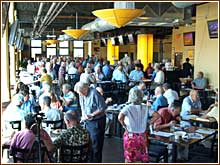
Photo: Hoag Levins
|
| Nearly 200 former RCA employees and history buffs packed The Victor's Pub for the Building 17 centennial celebration. Larger photo. | The Victor's Pub almost as if it's an industrial shrine.
"We have old Building 17 workers coming in all the time," said Sam Sarin, owner of the restaurant. "They come up to us saying 'I used to work here' and tell us stories about what it was like back then. Some of them sit at the windows talking about the RCA buildings that used to be out there where our parking lot is now. Some of them even bring in photos and signs and other RCA things that they want us to have. So, as you can see, we hang those on the walls."
Although once officially known as number 17, but colloquially called the "Nipper Building," the structure was extensively renovated and rebranded as "The Victor" in 2002 by developer Carl Dranoff. The floors above the restaurant are now luxury apartments.
Star of the afternoon's centennial show was Fred Barnum, L-3 Communications executive and author of
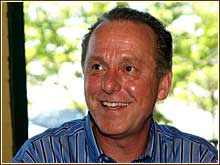
Photo: Hoag Levins
|
| L-3 Communications executive, former RCA employee and author Fred Barnum is the leading authority on RCA history. Larger photo. | "His Master's Voice," a book widely viewed as the definitive history of RCA and its predecessor companies. Using more than a dozen large LCD screens networked around the restaurant, Barnum gave a 90-minute multimedia presentation. It traced the history of The Victor Talking Machine Company, RCA Victor and RCA as institutions that once made Camden an industrial power at the same time their various inventions and products changed society.
For instance, during the first ten years of the 20th century, local Camden machinist Eldridge Johnson perfected the spring-driven mechanism that turned nascent sound recording experiments into a brand new mass-production industry: recorded music for the home. From a tiny ramshackle workshop on North Front Street, his music recording and record-making business literally exploded into a sprawl of 22 buildings that transformed downtown Camden.
While recognized for his organizational and manufacturing achievements, Johnson was more
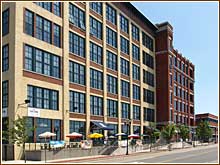
Photo: Hoag Levins
|
| The Victor's Pub is located on the ground floor of old RCA Building 17. In 2002 the building was converted into luxury apartments. Larger photo. | than that. Like John Wanamaker across the river, he was an intuitive advertising genius in an era when mass-market advertising was still emerging and defining itself as a culture-changing force. Victor Talking Machine's massive advertising campaigns were among the largest ever conducted at the time. And they constantly focused on creating an aura of exalted celebrity around the individual artists whose music Johnson recorded. As such, he played an enormous role in creating the publicity-driven music "star" system that is more of a force than ever in American life today.
In 1929, when Victor Talking Machine was combined with the Radio Corporation of America to create the RCA Victor Company, it was the world's largest producer of music records and its logo -- Nipper the dog -- was the world's most recognized brand icon.
One of the former RCA Building 17 employees who came back for the afternoon's presentation was
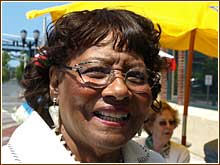
Photo: Hoag Levins
|
| "Camden has to pay more attention to its history," said Mayor Gwendolyn Faison. Larger photo. | Gwendolyn Faison, the current Mayor of Camden. She worked there from 1943 to 1964 as RCA emerged as a leader in the new business of broadcast televison.
"I still feel close to RCA," she said, standing on the entrance deck of Victor's Pub and squinting through the bright sunlight to briefly gaze up the cliff-like red brick wall of the structure. "This place is so full of history and I think we should be paying more attention to history when it so involves our city. Camden doesn't get the credit for what it deserves."
"When you mention the music business," she said, "kids today only think about Los Angeles or New York. Everybody knows how big the music business is but do they know it began here in Camden? We need to pay more attention to teaching our kids about that and learning more about it ourselves. When I look up at this tower, I'm just so proud that I was actually a part of all this."
Later, inside, Mayor Faison regaled attendees with stories
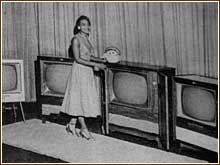
|
| Gwendolyn Faison was a model in RCA television set promotions in the late 1950s. Larger photo. | about what it was like to be a female supervisor overseeing an all-male production department back then. And she stood beamingly in front of two of the historic RCA photos hung on the Pub's wall: Both showing her as a model promoting RCA television sets in the late 1950s.
The entire north end of The Victor's Pub was turned into a mini museum for the day. It featured hundreds of historic antiques from the Victor Talking Machine Company, RCA Victor and RCA. The display was provided by L-3 Communications employee Ron McHugh, who has been collecting RCA artifacts for several decades.
Like Barnum or L-3 Communications graphic artist Jim DePietro, who was on hand to play music from his collection of RCA records, McHugh previously worked for years at RCA. All three men moved with their corporate unit when RCA was acquired by General Electric, which later sold the unit to Lockheed, which later merged
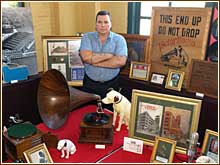
Photo: Hoag Levins
|
| L-3 Communications employee Ron McHugh has amassed a large collection of RCA artifacts. He set up a mini museum for The Victor's Pub event. Larger photo. | with Martin Marietta, which ultimately spun the unit off as L-3 Communications East, which remains headquartered in Camden.
A history buff who knows how to rebuild century-old Victrolas, McHugh first began collecting when he rescued RCA memorabilia from the company's trash. Today, his massive collection includes more than 5,000 items and he is often consulted by museums with collections from the early days of music recording.
"My father worked in this building for 40 years," said McHugh. "My brothers and aunts also worked here, so it was kind of like a family affair and it became a labor of love collecting all of this. That's how it is for most of the people who came here today. They're walking up to the display and remembering the exact places where some of these things used to be in the building or how the items were used or which ones were near where they worked. Some of the people here today built some of the equipment that you see on display."
The attendee who traveled the farthest to be at the Building 17 centennial event was Robert Harris,
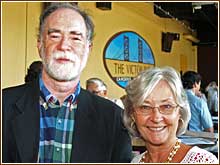
Photo: Hoag Levins
|
| Canadian Broadcasting Corporation reporter Robert Harris and Camden County Historical Society President Sandy Levins. Larger photo. | a reporter from the Canadian Broadcasting Corporation in Toronto. He's researching a five-hour radio series on the history of the North American music recording business that will air in October and November.
"So much of what became the standard procedures for the record business was invented here in Camden," said Harris. "There's such an industry around Thomas Edison in this area but Victor Talking Machine Company, oddly enough, is somehow a little left out. But Eldridge Johnson, who founded Victor, was really the guy who understood the record business. Not the technology business, which is what Edison knew so well. Johnson was the first person who understood how transformative music recordings would be for society as well as the marketplace. So, he and his company here in Camden are central to the story our radio series will be telling."
"In fact, the first thing my listeners will hear as the series begins are some of the voices of the people I'm interviewing here in Camden today. I can't think of a better place to start."
All Rights Reserved © 2009, Hoag Levins
HoagL@earthlink.net
About this Web site
| 








